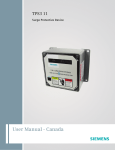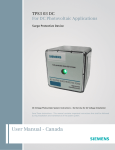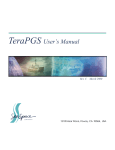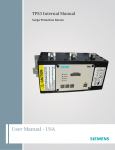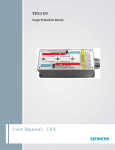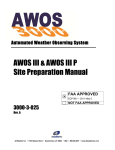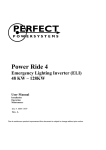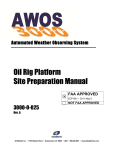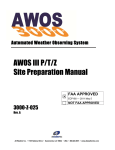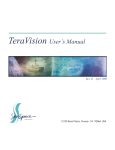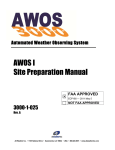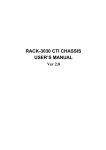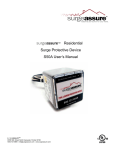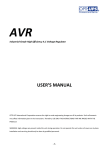Download User Manual - USA - TPS3 Surge Protection Resource Library
Transcript
TPS3 03 Surge Protective Device User Manual - USA V WARNING - Hazardous Voltage & Shock Hazard Failure to Follow These Instructions Could Result in Death or Serious Injury • • • • • • Only qualified licensed electricians should install or service SPDs Hazardous voltages exist within SPDs SPDs should never be installed or serviced when energized Use appropriate safety precautions including Personal Protection Equipment Failure to follow these instructions can result in death, serious injury, and/or equipment damage. This manual shall be read in entirety prior to installing Bonding and Grounding Hazard Verify that the neutral conductor in the service entrance equipment is bonded to ground in accordance with the National Electrical Code (NEC®) and all applicable codes. Verify that the neutral terminal (XO) on the secondary side of distribution transformers are grounded to the system ground in accordance with the NEC® and all applicable codes. During installation into an electrical system the SPD must not be energized until the electrical system is completely installed, inspected and tested. All conductors must be connected and functional including the neutral (if required). The voltage rating of the SPD and system must be verified before energizing the SPD. Failure to follow these guidelines can lead to abnormally high voltages at the SPD. This may cause the SPD to fail. The warranty is voided if the SPD is incorrectly installed and/or if the neutral conductor in the service entrance equipment or downstream of separately derived systems is not bonded to ground in accordance with the NEC®. Do Not Hi-Pot Test SPDs Any factory or on-site testing of power distribution equipment that exceeds normal operating voltage such as high-potential insulation testing, or any other tests where the suppression components will be subjected to higher voltage than their rated Maximum Continuous Operating Voltage (MCOV) must be conducted with the SPD disconnected from the power source. For 4-wire systems, the neutral connection at the SPD must also be disconnected prior to performing highpotential testing and then reconnected after test completion. Failure to disconnect SPD and associated components during elevated voltage testing will damage the SPD and will void the warranty. Introduction Thank you for choosing the Siemens TPS3 03 Surge Protective Device (SPD). TPS3 03 is a high quality, high energy surge suppressor designed to protect sensitive equipment from damaging transient overvoltages. The TPS3 03 is parallel connected such that circuit ampacity is unlimited. Proper installation is important to maximize performance. Please follow steps outlined herein. These instructions are not intended to replace national or local codes. Follow all applicable electrical codes to ensure compliance. Figure 1: SPD Types 2008 NEC Art 285 & UL 1449-3 SPD Types: Types 1, 2, 3, & 4 Based on Location within electrical distribution system (also coincides with ANSI/IEEE C62.41.2 - 2002 Categories C, B &A) VWARNING - Hazardous Voltage & Shock Hazard • • • • • • Only qualified licensed electricians should install or service SPDs SPDs should never be installed or serviced when energized or during electrical storms Use appropriate safety precautions including Personal Protection Equipment Failure to follow these instructions can result in death, serious injury, and/or equipment damage When used in outdoor applications, customer must seal the conduit nipple using watertight fittings (not included) to ensure a watertight connection Read this manual in entirety prior to installing Industry standards changes - 2009 UL 1449 Third Edition and 2008 NEC® Article 285 generated substantial changes. • • • • The term TVSS changed to SPD Types 1, 2, 3 & 4 SPDs are created UL 1449 clamping voltage performance testing changed from 500A to 3,000A UL 1449 added new I nominal testing (In), which consists of more rigorous duty-cycle testing The SPD Type category is important to understand before installing any SPD. Type 1 and 2 SPDs are fully UL Listed devices whereas Type 4 SPDs are UL Recognized devices. Type 1 – Installed on line or load side of the Main Overcurrent Protection (OCP), similar to what you knew as SSA, except now includes rigorous safety testing. Includes all OCP & safety disconnectors inside the SPD Type 2 – Installed on load side of the Main OCP, similar to what you know as hardwired SPD, and it may require external OCP. Type 3 – Point of Utilization, direct plug in type devices, similar to what you know as surge strips. Theses devices are intended for installation 10 meters from the panel (rational based on IEEE Cat. A location). Type 4 – Surge suppression components, could be a basic component or a complete module. Type 4 components can be tested for Type 1, Type 2 or Type 3 applications. For further information, please review latest editions of NEC® Art. 285, UL 1449, contact your local Siemens sales office or contact Siemens TPS Tech Support at 1.888.333.3545. The TPS3 03 is a Type 1 SPD. The TPS3 03 is suitable for use almost anywhere (not as a plug-in SPD). Type 1 SPDs are evaluated more rigorously by UL 1449 for 2008 NEC® Article 285 compliance. Type 1 SPDs and their connecting leads have been evaluated for line side applications without need for supplemental overcurrent protection. Type 1 SPDs include internal overcurrent protection. As a generalization, there are practical maintenance reasons for installing on the load side of the main overcurrent device (i.e. Type 2 installation). When connected on load side of main disconnect, we recommend connecting via a 30A circuit breaker due to 10 AWG conductors. The circuit breaker serves as a disconnect device and provides NEC® imposed short circuit protection to the conductors in Type 2 or 4 applications. Simplified Explanation of Operation SPDs sense overvoltage and create a momentary short circuit to redirect harmful surge energy to earth ground. SPD’s are not a one time device. They reset automatically and wait for the next surge. SPDs are capable of repeating this function thousands of times. Parts List and Inspection Items included in the package consist of the following: • 1 TPS3 03 SPD including 3’ (~1m) conductors • 1 Mounting L Bracket • 3/4” conduit nut • 2 Panhead mounting screws • 1 User’s Manual (this document) Carefully inspect each item in the package for signs of damage. If damage is found, please contact Siemens TPS Technical Support: 1.888.333.3545. For more information about this product or other Siemens products, visit www.usa.siemens.com. Figure 2: Dimensions and Weight 4.13” Weight: 1.60 lbs (0.73 kg) 3.26” 3.31” 3.26” 3.57” 3/4”-14 1.15” Sized for std 35mm DIN-rail Figure 3: Mounting options Voltage Rating & Application Before installing SPD, verify by nameplate voltage or model number that it has the same voltage rating as the power distribution system. If unsure, call Siemens TPS Tech Support at 1.888.333.3545 before proceeding. The SPDs specifier or user should be familiar with the configuration and arrangement of the power distribution system. The system is defined by how the secondary windings of the transformer supplying the service entrance main or load are configured. This includes whether or not the transformer windings are referenced to earth via a grounding conductor. The system configuration is not based on how any specific load or equipment is connected to a particular power distribution system. SPDs should be installed per the distribution system, not per a load or motor’s wiring connection. For example, suppose a 480V three phase motor appears to be connected as a 480V Delta. In actuality, the serving distribution system might be a 480Y/277V grounded Wye, with or without a neutral pulled to the motor or MCC. The system is still a 480Y/277V Wye, even though the load is connected as a Delta. A grounded Wye has a defined reference to ground (i.e., neutral is bonded to ground). In contrast, some Delta systems are ungrounded, which have no reference to ground. Table 2: Model Number Decoder Model Std. 3/4”-14 Nipple • • • DIN-rail Mount (rail not incl.) Bracket Mount for flat surfaces 3/4” pipe nipple (conduit nut included) Standard 35mm DIN-rail (not included) L-bracket tightens onto DIN-rail Standard flat mounting surface Attach L-bracket to surface via mounting holes TPS3A03 TPS3B03 TPS3C03 TPS3D03 TPS3E03 TPS3F03 TPS3G03 TPS3K03 TPS3L03 TPS3S03 Voltage Code A B C D E F G K L S System/Service Voltage 240/120V 1Ø, 3W Plus Ground, 240/120V 3Ø, 4W Plus Ground High Leg Delta 208Y/120V 3Ø, 4W Plus Ground 240v 3Ø, 3W Plus Ground 480Y/277V 3Ø, 4W Plus Ground 480v 3Ø, 3W Plus Ground 600v 3Ø, 3W Plus Ground 380Y/220V 3Ø, 4W Plus Ground 600Y/347V 3Ø, 4W Plus Ground 400Y/230V 3Ø, 4W Plus Ground TPS3 03’s have demonstrated 200kA Short Circuit Current Ratings (SCCR) including leads (120/240V Split phase models have 100kA SCCRs). See UL Label markings on SPD or see Data Sheet for specs.) Supplemental overcurrent protection is not required to protect this SPD. SPDs on Ungrounded Systems However, NEC® convention requires that connecting conductors have overcurrent protection in Type 2 or 4 applications. Follow applicable Caution – Ungrounded systems are inherently unstable and can codes. produce excessively high line-to-ground voltages during certain fault conditions. During these fault conditions, any electrical equipment This device features internal overcurrent and overtemperature including an SPD, may be subjected to voltages which exceed their protection that will disconnect effected surge suppression components designed ratings. This information is being provided to the user so at the end of their useful life, but will maintain power to the load – now that an informed decision can be made before installing any electrical unprotected. If this situation is undesirable for the application, follow equipment on an ungrounded power system. these instructions for replacing the device. TPS3 03 is ultrasonically welded closed and contains no user serviceable parts. Table 1: Specifications Specifications Temperature Operating -40oC (-40oF) to 60oC (+140oF) Temperature Storage -55oC (-67oF) to 65oC (+149oF) Wire Size & Installation Torque 10 AWG; 18 inch-pounds Appropriate Circuit Breaker based on conductor size 30A (SPD includes internal OCP) NEMA 250 Enclosure Rating Type 4X with appropriate sealing & sealing condulets V DANGER V CAUTION Hazardous voltage. Will cause death or serious injury. CONDUCTING DIELECTRIC AND/OR HI-POTENTIAL TESTING WILL CAUSE INTERNAL DAMAGE TO TPS3 UNIT. Keep Out. Qualified personnel only. Disconnect and lock off all power before working on this equipment. Do not perform dielectric or high potential tests with the TPS3 unit installed. TPS3 03 Installation Instructions Figure 4: Typical Panel Installation To Protected Loads Pre-Plan your installation. You need to accomplish the following: • • • • • • • • Meet all National and Local codes (NEC® Article 285 and UL 1449 address SPDs) Confirm System voltage to SPD voltage (120V SPD will fail instantly on 240V, 277V, etc.) Mount SPD as close to panel or equipment as possible to keep leads short (long leads hurt performance substantially) Ensure leads are as short and straight as possible, including neutral and ground, as equipped. If using a breaker, use a breaker position that is close to the SPD and the panel’s neutral & ground If using a breaker, recommended breaker size is 30A due to 10 AWG conductor Make sure system is grounded per NEC® and clear of faults before energizing SPD (inadvertent system problem may fail SPD). Never Hi-Pot test Any SPD (will prematurely fail SPD) Do not install the TPS3 03 through the bottom of a NEMA 3R panel. Dripping water will prematurely fail the SPD. 1. Use voltmeter to check voltages and ensure correct SPD. See Data Sheet for specs & wire-outs 2. Determine Mounting method (See Figure 2) – weather resistant equipment may be required 3. If SPD has optional Dry Contact, pre-plan its installation 4. Remove power from panel/source. Confirm panel/source is deenergized. 5. Identify breaker location and SPD location. Position SPD such that LED is best visible. 6. Mount SPD – weather resistant applications require additional sealing, o-rings, etc. (not included) A B • Use closest breaker to SPD • Locate SPD close to intended breaker C BREAKER N • Keep Leads Short as Possible • Avoid Sharp Bends G • Rotate SPD such that LED indicator is most visible • Outdoor installation requires appropriate weather sealing at nipple (o-ring, sealing conduit, etc.) Figure 5: Sealing o-rings Sealing gasket: two choices 1.) At 3/4" nom. thread: ID is 1.05" 2.) At 0.14" high 'base step': ID is 1.25" -- Remove an appropriately sized knockout from panel. -- Connect conductors as appropriate – short and straight as possible (Hi-Legs are Phase B) 7. Label or mark conductors as appropriate (neutral: white, ground: green, energized: black, hi-leg: orange) 8. Make sure system is bonded per NEC® and is clear of hazards or faults before energizing (N-G bonding not per NEC® will fail SPDs: #1 cause of SPD failures) 9. Energize and confirm proper operation of green LED indicator and/or options. Figure 6: LEAD LENGTHS LEADS: SHORT & STRAIGHT CUT EXCESS; DO NOT COIL OR LOOP X Not Good p Good • • • CUT OFF EXCESS LENGTH DO NOT LOOP OR COIL SHORT & STRAIGHT Connecting Optional Form C Dry Contact & Audible Alarm (“D” suffix near end of model number) Figure 7: Dry Contacts Three (3) 3’ (~1m) 18 AWG wires are included through the nipple with this option. (These are smaller than the 10 AWG SPD conductors.) Gray is Common, Red is Normally Open and Blue is Normally Closed. (We generally recommend the Normally Closed configuration because it detects disconnected or failed wiring whereas normally open does not.) Dry Contact Leads Power Leads If the dry contacts are not utilized, insulate lead ends, coil and secure. Audible alarm will still function correctly. The contact is rated 250V, 5A. Higher energy applications require supplemental relaying. This option monitors suppression element condition and is not intended for use as phase loss or phase detection monitoring. Normal Operation Green LED Indicators Each phase’s LED Indicator illuminates when the SPD is energized and operating correctly. Every suppression element is monitored and connected by logic to the LED. Should any suppression element fail, the green LED will extinguish. Form C Dry Contact and Audible Alarm Option Similar to the Green LEDs above, the dry contact will change state and the audible alarm will sound upon suppression element failure. The audible alarm may be silenced by removing power to the SPD. 6 • • Normally Closed (suggested): Use Gray and Blue Normally Open: Blue Use Gray and Red Red Blue Grey Normally Closed Gray Common Red Normally Opened V DANGER V CAUTION Hazardous voltage. Will cause death or serious injury. CONDUCTING DIELECTRIC AND/OR HI-POTENTIAL TESTING WILL CAUSE INTERNAL DAMAGE TO TPS3 UNIT. Keep Out. Qualified personnel only. Disconnect and lock off all power before working on this equipment. Do not perform dielectric or high potential tests with the TPS3 unit installed. Maintenance Warranty and Customer Service SPDs require minimal maintenance. Periodic inspection of diagnostic indicators is recommended to ensure proper operation. Limited Warranty Troubleshooting & Service Please contact us for any service related issues. Quality SPDs withstand severe duty and attempt to protect their load until failure. There are electrical anomalies that SPDs cannot protect against. These are generally Sustained Overvoltages also known as Temporary Overvoltages (TOVs). In this context, Sustained Overvoltages may be only a few cycles. Failed SPDs tend to be symptoms, not root causes. A failed SPD is usually a sign of other problems within the electrical distribution system. As a generalization, the single largest cause of SPD failures is reference to ground issues. If the SPD shows problems on startup, there is reasonable chance of bonding/grounding/misapplication issue. This permanently damages the unit. If not corrected, it will happen again. Siemens warrants its TPS3 03 protection products against defective workmanship and materials for 5 years. Liability is limited to the repair or replacement of the defective product at Siemens’ option. A Return Material Authorization number (RA#) must be given by the company prior to the return of any product. Returned products must be sent to the factory with the transportation charges prepaid. In addition, the company also warranties unlimited replacement of modular and component parts within the warranty period previously described. The company specifically disclaims all other warranties, expressed or implied. Additionally, the company is not be responsible for incidental or consequential damages resulting from any defect in any product or component thereof. The sales contract contains the entire obligation of Siemens. This instruction manual shall not become part of or modify any prior existing agreement, commitment or relationship. Technical Support 1.888.333.3545 Prior to calling Siemens TPS3 Technical Support for assistance or ordering parts, please have the following information available: TPS3 model number: ________________________________ Manufacture date: _________________________________ Date of Purchase: ___________________________________ Your order number: _______________________________ Return Shipment Address: Siemens - Attn: RA #___________ 14550 58th Street North Clearwater, FL 33760 7 Siemens Industry, Inc. 5400 Triangle Parkway Norcross, GA 30092 1-800-964-4114 info.us@siemens.com 7.30.12.jb #8175









